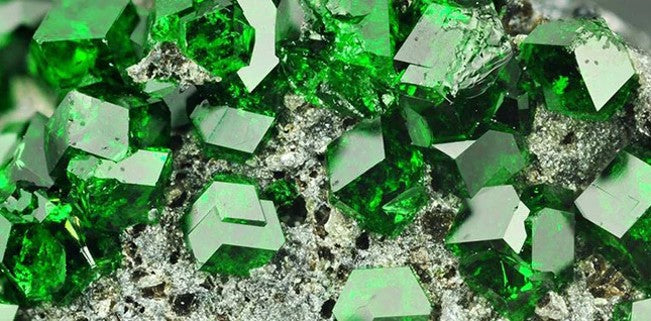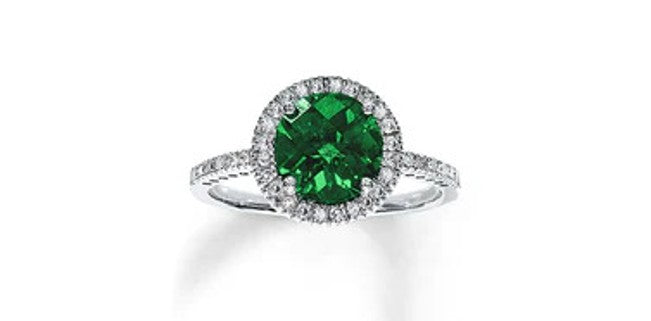Natural vs. Lab Created Emeralds

Emeralds, or natural beryl, are associated with May birthdays, 55th anniversaries, and qualities like loyalty and love. They are the rarest of the colored gemstones and a much softer gem, making them more expensive and highly desirable. Naturally occurring emeralds are especially pricey as they are hard to come by.
Emeralds form when elements like beryllium bubble up from the earth's crust into hydrothermal veins. Deriving their beautiful green color from elements like chromium, vanadium, and iron. Color is the most important factor in choosing an emerald. Unlike diamonds, an emerald's beauty relies on color and saturation more than brilliance--leaving the final choice up to the preference of the viewer's eye. Emeralds are becoming an increasingly popular addition to engagement rings, due to their symbolism and beautiful hues. Emeralds can be found as light greens or dark greens, giving buyers many options to suit varying tastes.
TABLE OF CONTENTS
Understanding Emerald Quality
An emerald's worth is graded on a scale ranging from B (least valuable) to AAA (most valuable). A raw emerald's value lies mostly in its color and saturation, as the hardness is fairly consistent—emeralds are fragile—and clarity and brilliance are less important for emeralds than for diamonds. The buyer has a large say in how light or deeply colored she prefers the stone to look. Quality is also determined by whether the emerald is natural or lab created, with natural diamonds bearing a higher quality.

Natural vs. Lab Created
Natural emeralds almost always contain more inclusions, or visual variations due to minerals within the gemstone, than other colored stones. These inclusions might look like tiny flaws or irregular pattterns, but don't worry they are not something to be worried about. In fact, these inclusions can make a gem and a piece of jewelry more personal and unique. Natural emeralds occur in countries like Colombia and Brazil and have a deep green color we have come to expect.
Lab created emeralds or lab grown emeralds differ in color and contain no inclusions. Some view this as preferable, as inclusions can be seen as flaws. Synthetic emeralds are identical to natural ones in chemical composition and similar in appearance, although color and saturation variations may be detected by the eye alone. Man-made emeralds lack the rarity and detail of natural emeralds, as well as, in many cases, the expected color and saturation. It is important to note the difference between terms: while lab created emeralds are real emeralds, they are not considered to be authentic emeralds, as they are fabricated in a lab and did not occur in nature.
Lab created emerald or grown emerald, usually come with a lower price tag than natural ones of similar color, but the price difference is matched by a difference in appearance. Therefore, affecting quality. An emerald of the same quality on the emerald scale (AAA-B) may still be deemed less valuable because of an inferior appearance or a slightly off-color. The naked eye can detect this kind of irregularity, and a buyer may notice that a synthetic emerald simply does not look quite right. Ultimately, it may be better to size down or choose a different cut rather than opting for a man-made emerald.

Emerald Jewelry
Emerald is considered a unique alternative in engagement rings, either as the accent stone or as the center stone. Diamond engagement rings of all styles can be modified to seamlessly incorporate emeralds for a richer, more colorful engagement ring. Emeralds also stand alone to make beautiful jewelry ranging from earrings to necklaces. Natural emerald rings can sport a single emerald cut (known for brilliance) or a round cut. Natural emerald earrings have a classic look and add a luxurious feel to any ensemble. A necklace pendant may also contain a natural emerald. Emerald jewelry is both timeless and noticeable, making it a great investment and a personal, meaningful gift.
Emerald cuts—so named for their ability to accent the brilliance and saturation of natural emeralds—are the most popular, closely followed by round cuts that work especially well in emerald engagement rings. Oval and pear cuts, also quite frequently seen, especially work in natural emerald necklaces. Emerald jewelry of any sort benefits from the detail and coloring of a natural emerald.
FAQs
How much are emeralds worth?
What month is emerald the birthstone for?
What color is an emerald?
Where are emeralds found?









